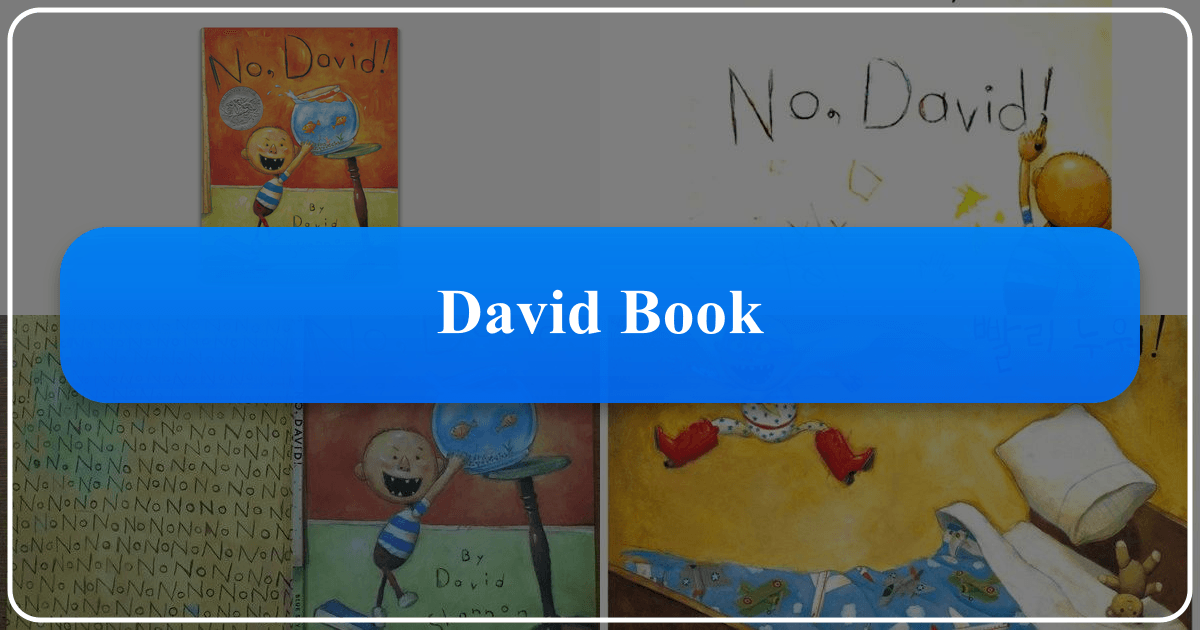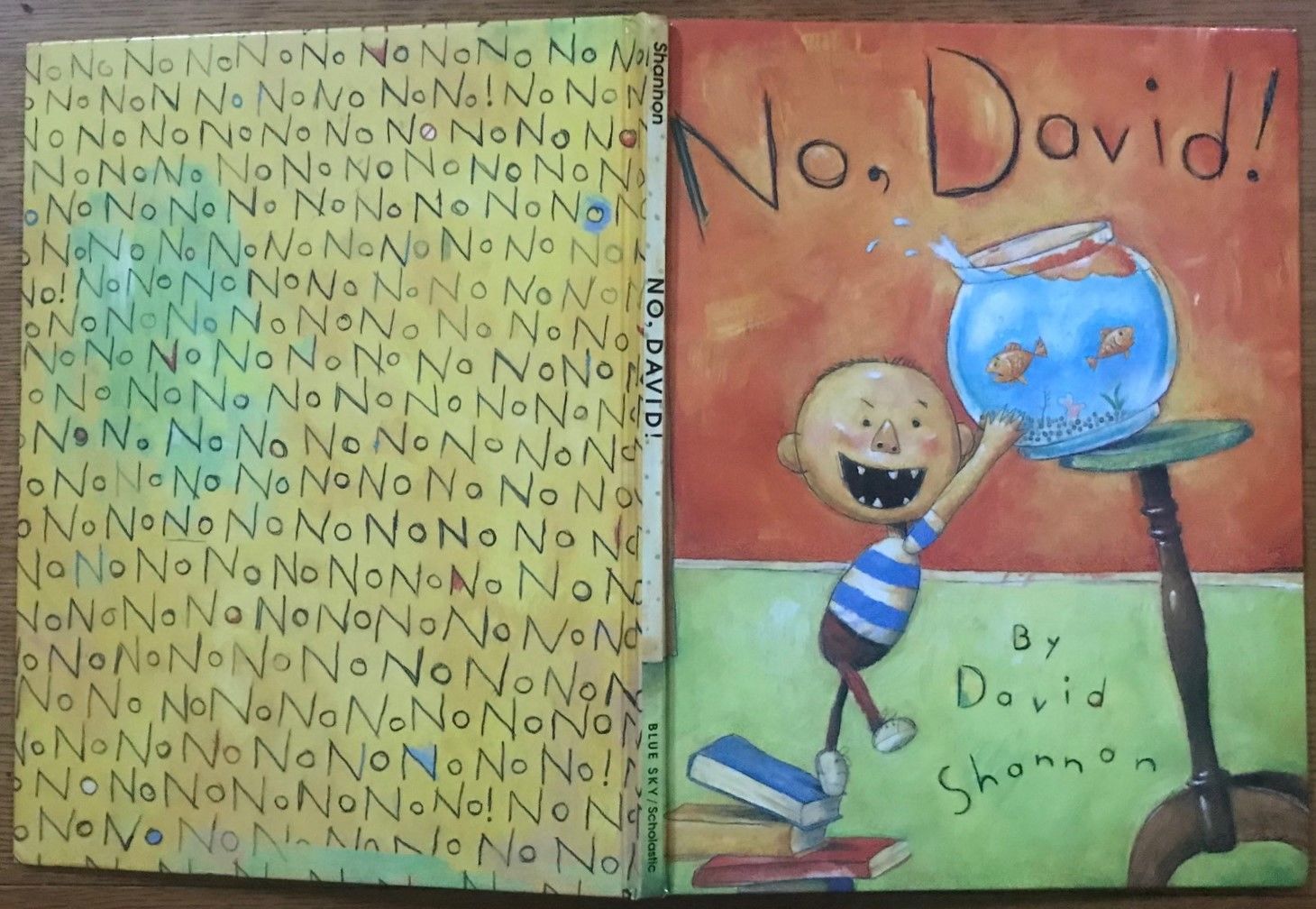*No, David!* A Deep Dive into a Children's Classic

No, David! is a 1998 children’s picture book written and illustrated by David Shannon and published by Scholastic Inc. It’s a deceptively simple story that resonates deeply with both children and adults, exploring universal themes of childhood, discipline, and parental love. This exploration will delve into the book’s origins, its narrative structure, thematic analysis, critical reception, enduring legacy, and its broader cultural impact, referencing the various categories suggested for a comprehensive review: Books, Authors, Reading and Learning, Libraries, and Cultural Impact.
1. Books: Genre, Reception, and the No, David! Series
No, David! falls squarely into the children’s picture book genre, specifically leaning towards comedic storytelling. The book’s humor arises from the relatable, albeit mischievous, antics of the protagonist, David, and the consistent, exasperated “No, David!” from his mother. This simple repetition coupled with the vibrant illustrations creates a rhythm and humor that engages young readers. Its success lies not only in its comedic element but also in its underlying message of parental love and the challenges of raising children.
The book’s critical reception has been overwhelmingly positive, evidenced by a collection of awards and honors received since its initial publication. No, David! was recognized as one of the New York Times’ Best Illustrated Children’s Books in 1998, further solidifying its place amongst the most celebrated children’s literature. It also received a Bulletin of the Center for Children’s Books Blue Ribbon in 1998 and the Caldecott Honor distinction in 1999. The book’s continued popularity is reflected in its listing as one of the National Education Association’s “Teachers’ Top 100 Books for Children” in 2007, and as one of School Library Journal’s “Top 100 Picture Books” of all time in 2012.

Despite its generally positive reception, No, David! has not been without controversy. Certain illustrations have led to the book being banned in some school districts, prompting discussions about censorship and the representation of childhood behavior in children’s literature. These varied responses highlight the book’s ability to spark conversations about discipline, appropriate behavior, and the complexities of parental relationships.
The success of No, David! spawned a series of sequels and related books, extending the adventures of David and offering opportunities to explore different facets of childhood development. These include:
Sequels: David Goes to School, David Gets in Trouble, Good Boy, Fergus!, It’s Christmas, David!, Grow Up, David! and That’s Not Funny, David! These books continue to build on the established character and narrative style, showing David’s growth and continuing misadventures.
Prequels: David Smells!, Oh, David!, Oops! These prequels offer a glimpse into David’s younger years, providing further context to his character.
Sticker and Activity Books: Uh-oh, David! These interactive books engage children in a playful way with the beloved character and themes.
The No, David! series’ longevity indicates a consistent demand for the book’s engaging narrative style and universally understood themes of childhood and family dynamics. These books have become staple titles in libraries and homes, providing ongoing entertainment and educational value.
2. Authors: David Shannon’s Life and Work

David Shannon, the author and illustrator of No, David!, has a personal connection to the book’s narrative. He originally wrote the story when he was five years old, using only the words “No” and “David” because those were the only ones he knew how to spell. This early childhood creation later became the inspiration for the published book, revealing an intriguing insight into the author’s own childhood experiences and reflecting a deeply personal understanding of children’s behavior. Rediscovering this childhood work years later and deciding to rewrite and publish it demonstrates a creative process steeped in self-reflection and a unique perspective on the theme of childhood. The author’s note at the end, which highlights the contrast between the frequent “No” of childhood and the occasional, precious “Yes,” further emphasizes this personal connection and adds an additional layer of meaning for readers.
Shannon’s writing style is characterized by its simplicity and directness, perfectly suited to his young target audience. His illustrations are equally straightforward and expressive, using bold colors and exaggerated features to capture the emotions and energy of David’s actions. The visual style complements the narrative, enhancing the comedic effect and clearly conveying the consequences of David’s choices. His distinct artistic style and ability to capture the essence of childhood have made him a well-known and beloved author and illustrator of children’s books. The illustrations of No, David! are crucial to the book’s success; they foreshadow plot developments and reinforce the narrative’s message. This masterful interplay between text and image is a hallmark of Shannon’s style.

2.1 Inspirations and Famous Works
While the inspiration for No, David! is undeniably personal, Shannon’s body of work reveals a broader fascination with childhood experiences, family life, and the humorous aspects of everyday life. His other well-known works, such as A Bad Case of Stripes, The Day the Crayons Quit, and No, David!’s sequels, showcase a similar approach to storytelling, combining simple text with dynamic illustrations to create engaging narratives for children.
3. Reading and Learning: Themes and Educational Value
No, David! transcends its entertainment value; it provides valuable educational lessons for young readers. The book presents several important themes that are crucial for social and emotional development in children.
3.1 Themes in No, David!
Discipline and Proper Behavior: The repeated “No, David!” serves as a clear illustration of the importance of rules and boundaries. David’s actions vividly showcase the consequences of misbehavior.
Parental Love and Patience: Despite the constant reprimands, David’s mother’s love remains consistent. The story emphasizes the importance of parental patience, understanding, and consistent love. The final embrace signifies the unconditional nature of parental love.
The Essence of Childhood: David’s mischievous acts offer a realistic portrayal of a young child’s world, filled with curiosity, energy, and the inevitable testing of limits. This resonates deeply with children, validating their experiences and feelings.
3.2 Educational Value and Life Lessons
No, David!’s simplicity makes it ideal for reading aloud to young children, fostering a connection between the child and caregiver. The book facilitates discussions about appropriate behavior, empathy, self-regulation, and the importance of following rules. The story’s repetitive structure and strong visual elements make it effective for promoting literacy skills, vocabulary development, and comprehension. The book also offers valuable life lessons related to accepting consequences and demonstrating responsibility. The story’s ending, where David’s mother ultimately embraces him, emphasizes the importance of forgiveness and reconciliation, teaching young readers about resolving conflict and demonstrating love even after misbehavior.
No, David! can serve as a springboard for conversations between parents and children, offering a context to discuss feelings and the importance of managing emotions. The book’s educational value extends beyond simple literacy; it contributes to social-emotional learning, and helps cultivate a positive parent-child relationship built on understanding and love.
4. Libraries: Accessibility and Preservation
No, David! is widely available in public and digital libraries around the world, ensuring that its message can reach a broad audience. The book’s digital availability expands its accessibility, making it accessible to a wider range of readers, irrespective of geographic location or physical limitations. The book’s enduring popularity has ensured its preservation in various library collections, both physical and digital. The various reprints and editions released throughout the years further attest to the book’s importance and enduring relevance.
5. Cultural Impact: Awards, Adaptations, and Community Engagement
The numerous awards No, David! has received reflect its significant cultural impact. These accolades highlight the book’s artistic merit, its storytelling effectiveness, and its contribution to children’s literature. The book has had a significant impact on how families and educators engage with the topic of discipline and parenting. The book’s enduring popularity has inspired various discussions, activities, and educational resources. The creation of various derivative works, including sequels, prequels and activity books, demonstrates the book’s enduring appeal and influence. No, David! continues to engage communities through its portrayal of universal experiences and the encouragement it provides for open conversations within families. The ongoing popularity of the book signifies its continued importance in shaping perspectives on early childhood development and the parent-child relationship. Its availability in numerous formats and languages further underscores its influence on a global scale.
In conclusion, No, David! is far more than just a children’s picture book. Its enduring popularity stems from its simple yet powerful message, its relatable characters, and its visually engaging presentation. The book’s exploration of universal themes concerning childhood, discipline, and love has solidified its place as a classic in children’s literature, ensuring its continued relevance and impact on generations to come. Its accessibility through various platforms and its influence on related educational materials confirm its enduring cultural significance.